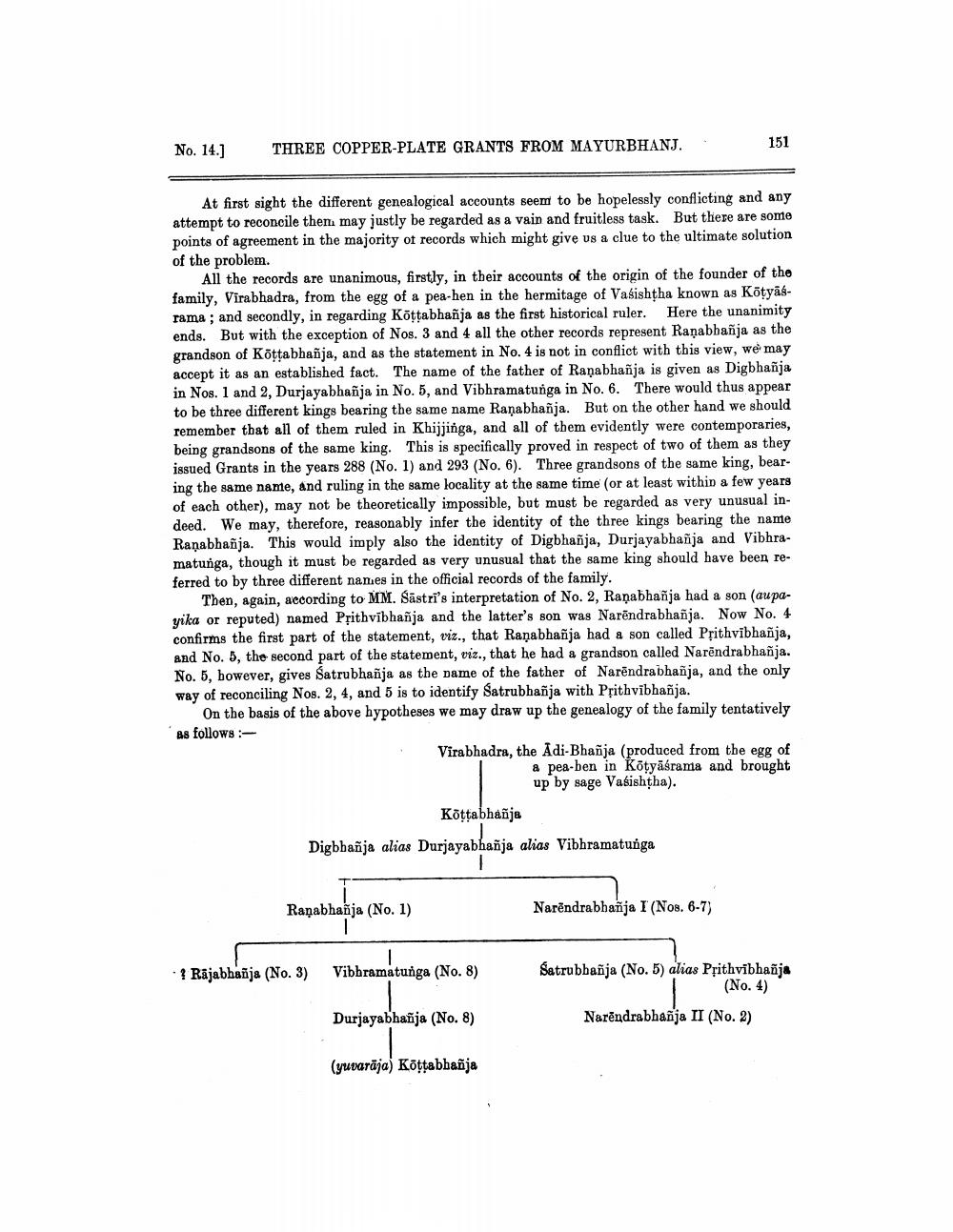________________
No. 14.1
THREE COPPER-PLATE GRANTS FROM MAYURBHANJ.
151
At first sight the different genealogical accounts seem to be hopelessly conflicting and any attempt to reconcile then may justly be regarded as a vain and fruitless task. But there are some points of agreement in the majority of records which might give us a clue to the ultimate solution of the problem.
All the records are unanimous, firstly, in their accounts of the origin of the founder of the family, Virabhadra, from the egg of a pea-hen in the hermitage of Vašishtha known as Kötyásrama; and secondly, in regarding Köttabhañja as the first historical ruler. Here the unanimity ends. But with the exception of Nos. 3 and 4 all the other records represent Raņabhañja as the grandson of Kõttabbañja, and as the statement in No. 4 is not in conflict with this view, we may accept it as an established fact. The name of the father of Raṇabhañja is given as Digbhañja in Nos. 1 and 2, Durjayabhañja in No. 5, and Vibhramatunga in No. 6. There would thus appear to be three different kings bearing the same name Raņabhañja. But on the other hand we should remember that all of them ruled in Khijjinga, and all of them evidently were contemporaries, being grandsons of the same king. This is specifically proved in respect of two of them as they issued Grants in the years 288 (No. 1) and 293 (No. 6). Three grandsons of the same king, bearing the same name, and ruling in the same locality at the same time (or at least within a few years of each other), may not be theoretically impossible, but must be regarded as very unusual indeed. We may, therefore, reasonably infer the identity of the three kings bearing the name Raņabhañja. This would imply also the identity of Digbhañja, Durjayabhañja and Vibhramatunga, though it must be regarded as very unusual that the same king should have been referred to by three different names in the official records of the family.
Then, again, according to MM. Šāstri's interpretation of No. 2, Ranabhañja had a son (aupayika or reputed) named Prithvibhañja and the latter's son was Narēndrabhañja. Now No. 4 confirms the first part of the statement, viz., that Ranabhañja had a son called Prithvibhañja, and No. 5, the second part of the statement, viz., that he had a grandson called Narēndrabhañja. No. 5, bowever, gives Satrubhañja as the name of the father of Narēndrabhañja, and the only way of reconciling Nos. 2, 4, and 5 is to identify Satrubhañja with Prithvibhañja.
On the basis of the above hypotheses we may draw up the genealogy of the family tentatively as follows:
Virabhadra, the Adi-Bhañja (produced from the egg of
a pea-ben in Kötyäśrama and brought
up by sage Vasishtha).
Kottabháñja Digbbañja alias Durjayabhañja alias Vibhramatunga
Raņabhañja (No. 1)
Narendrabhañja I (Nos. 6-7)
. ? Rājabhäñja (No. 3)
Vibbramatunga (No. 8)
Satrubbañja (No. 5) alias Prithvibhañja
(No. 4) Narēndrabhanja II (No. 2)
Durjayabhañja (No. 8)
(yuvarāja) Kõttabbañja




